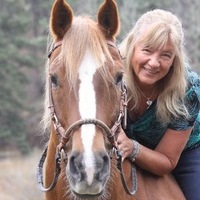
The Most Popular Horse Breeds Of 2019
Equestrian Advice & Guides General Equestrian
Build your business profile for FREE and expose your services to thousands of potential clients!
Create my profile now!
Have you ever felt off-balance while riding, or sore in any of your joints when you dismount? Wonder if you are sitting correctly or not? Everyone has heard the old saying about having a line from your shoulder through your hip and down to your heel, but what does that mean?
You’d think an article on leg position would talk specifically about legs, but since all body parts are part of a whole, we must discuss each of them.
The Line:
The simple answer is to envision an imaginary line from your ears, through your shoulders, to your hips and down to your heels. If you do not have anyone to evaluate your position, simply have someone take pictures of you while you ride at different gaits and do your own diagnostic review on yourself!
Balance:
You should be sitting astride the horse in the same position as you would if you were standing on your own two feet without a horse, so that if your horse disappeared from beneath you, you’d find yourself standing, not flat out on your stomach or back.
Arms:
A quick note here about elbows, even though not part of your leg; if your elbow are straight, your shoulders will round, your spine will lock, your pelvis, knees and ankles will brace and set. This will make you off-balance and out of alignment. Riding with your arms. Hanging from your shoulders, with bent elbows fixes this and help you keep in balance on every ride, at every gait, over all terrain.
Feet:
As when standing on your own two feet, you will have no locked joints. No locked knees, ankles, hips or feet. Starting from the bottom, your toes are relaxed and soft in your boot. Your ankle is soft, mobile and though you should have a little weight in your heels, you don’t appear to be pushing against the stirrup. Your knees are slightly bent, whether you are riding English or Western and your inner thigh is in contact with your saddle. If you are using your hamstrings (these are huge, strong muscles that want to do the job, but don’t let them) you will see that your hips are now locked and your pelvis can’t rock. To prove this, stand up now, and flex your hip joint at the top of your thigh so that your knees point out slightly and are bent to keep your balance. Try walking. You can’t, unless you teeter along like a broken toy!
Hips:
Once your hips lock, your lower back is inflexible and you’ll need to push your bottom out behind you in order to move. Picture doing that on a horse and it becomes clear that once one joint locks into an immobile position they all must adjust; all the way from your feet to your shoulders. Without fluidity and motion, your horse will be hindered and may not want to move ahead because your body is telling him not to go, but rather, to stop. This is usually when people bring spurs and whips into the picture, when really, if they managed their own body mechanics properly, their horse would also better manage his.
At each gait while riding on flat ground, your body will adjust slightly all on its own because, well, it’s physics actually. If you stand up again and trot around your room, you’ll see that your upper body will automatically tip slightly forward, but you didn’t need to “tell” it to do so. Same thing is true while riding.
Upper body:
So what happens on a trail ride, when the ground is hilly? Do you hold still, keeping that line from ear to heel? Not really, not how you may envision, anyway. To demonstrate, get up and go up some stairs, or walk up an incline in your yard. Keep aware of what your legs are doing, but also keep track of your upper body. See how your lower back adjusts to the climb? How you lean slightly forward? This is just physics doing its thing and is exactly what will happen naturally as you ride your horse. If you can watch another rider, you’ll see that her body will lean forward going up and slightly backward going down a hill. Now, if you think about it and try to do manage how much or how little to lean, you may find it more difficult than if you simply follow your horse.
You’ll want to be aware of being balanced so that your legs are under you and the line from elbow to your horse’s mouth is straight, and you don’t feel like you are being pitched forward or like you’re going to fall off the back end.
Joints, all of them:
The key is to be relaxed in your joints, allowing them to move with your horse. If your feet are tense and “standing” against the stirrup, you’ll find your knees lock and discomfort becomes pain before you’ve ridden very long. Lengthening the stirrups is the solution in this case.
If you can get someone to take pictures of you from the side as you ride on the flat, up and down hills and over differing terrain, you’ll better be able to see how to ride balanced in any condition. The answer to legs and body position is flexibility, fluidity and the ability to follow motion. Keep balanced and enjoy every ride, every time, Happily Ever After!
~Tanya Buck
Tanya Buck.com
FREE Today: Balancing both you and your horse, plus you will be signed up for other free goodies all year! https://lp.constantcontactpages.com/su/ou9pQ9C/balancetips

